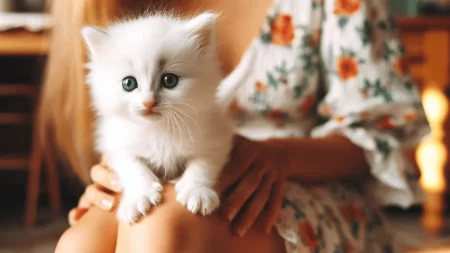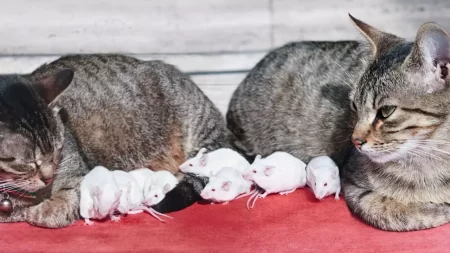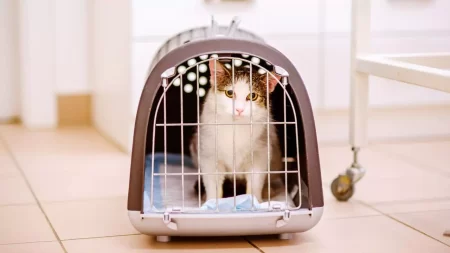Have you ever noticed that cats always seem to meow just when you can’t see them? It’s as if they know that you can’t respond, so they use the time to their advantage to make a few extra vocalizations. What I’ve come to realize is that cats meow when they can’t see you because it’s their way of communicating with you in a different way.
Have you ever noticed that your cat seems to call out your name even when they can’t see you? It’s common for cats to meow when they can’t see their owners, usually when they are alone in the house and believe the person is nearby or nearby but not visible. This behavior is a form of communication that cats use to get your attention or show recognition and affection.
Although meowing is usually seen as a form of communication among cats, it also serves as an effective way for cats to express their feelings and needs to their human companions. When meowing, cats may be:
- asking for food or attention
- seeking affirmation from you like a child would from its parent
- sharing their excitement over something new
- protesting against being alone
- letting us know if something makes them nervous, such as unfamiliar people entering the home or loud noises like storms
Essentially, cats may be letting us know so we can provide them with safety and security.
What is a Cat’s Natural Instinct to Meow?
As a cat owner, I have surely asked myself this question; why do cats meow when they can’t see me? It’s a curious phenomenon that cats seem to reserve this sound solely for humans. After all, cats don’t usually vocalize with other cats to communicate.
A cat’s natural impulse is to communicate with other cats through scent and body language signals rather than vocalizations. So why do they suddenly start meowing desperately when they don’t even see you in their vicinity?
There are a few possibilities that might explain this behavior:
- First, meowing is how kittens communicate with their mothers for feeding and nurturing. Even as grown-ups, cats continue to use vocalizations as part of their interactions with people since it has become so ingrained in them.
- Secondly, some studies suggest that meowing is instinctual for cats and it could be an evolutionary adaptation used by mother cats to keep their vulnerable young ones safe from predators (or from getting lost).
- Lastly, pets demonstrate signs of domestication after long periods of being around humans – so much so that some behaviors exhibited by our furry friends have evolved specifically to help them get attention more efficiently. This isn’t true in every case but it might account for the fact that your cat will occasionally “talk” even when you’re not really around!
Whatever the case may be, it’s clear that the answer lies somewhere deep in our pet’s past – and it can only make us appreciate all the more our adorable and mysterious felines.
How Do Cats Communicate With Meows?
Have you ever been around a cat who meows even when you can’t see them? This kind of communication between cats and their owners is something that has fascinated me for many years.
In the wild, cats communicate through scent, body language, and sound, though the sound is generally only used when one cat is trying to warn the other of an impending attack from outside predators. Domestic cats still use these same methods to communicate with one another and with their human counterparts.
When it comes to vocalization, cats meow as a way to express various needs – hunger, thirst, attention, or just some friendly conversation. Their tone varies depending on the emotion they wish to convey – one meow might mean they’re feeling content while another may be meant as a warning.
Cats also have different types of vocalizations such as purrs, chirps, and even growls that can help us distinguish between different types of emotions. When we can’t see them but hear them meowing it’s often an indication that they need something or just want our attention. By understanding why they’re meowing in this way we can better understand our pet’s needs and work on meeting those needs more effectively which in turn will help our relationship blossom even more!
What Do Cats Mean When They Meow?
My cats meow at me when I’m not visible to them. Is this just a coincidence, or could they actually be trying to communicate something?
When cats meow, it’s usually their way of communicating a need or desire. They may be asking for food, requesting attention, greeting someone they recognize, or trying to let you know that something is wrong. In fact, the “meow” sound is the only vocalization cats use for communication with humans. While we can’t be sure what cats mean when they meow without us present, it’s likely that if your cat is meowing at an invisible you, then it’s either seeking out your attention or giving you a greeting.
The long-time bond between humans and cats has led them to develop a variety of ways of communicating with us – through physical cues (rubbing up against furniture and other objects) as well as through vocalizations. Of course, not all meows are created equal; some cats may appear more insistent than others when they’re asking for something specific. Generally speaking, though it’s always best to respond positively to your cat’s actions in order to strengthen trust between you two!
How Do Cats React to Different Tones of Voices?
Humans aren’t the only ones who relay emotion in their voices. Cats have the amazing ability to distinguish different tones of voices and can even perceive the emotions behind them. When cats are trying to make contact with you, they will often meow at an unusually high pitch as a form of communication. This behavior is most commonly used when cats can’t visually recognize you, whether you’ve just arrived home after being away or they’re in an area like another room that they can’t see into. A higher-pitched meow indicates that your cat is happy to see you and could mean anything from “hello” to “how was your day?”
However, it’s important to take note of how much and how loud your kitty is meowing – this could be a sign that there’s an underlying concern like boredom or hunger depending on the situation. If your cats meow persistently, chances are they want something from you such as attention or food, but it can also be a sign that something isn’t quite right. To figure out what your cat wants or needs, it’s best to speak back using different tones of voice until you hit the sweet spot! Soft talking is usually best when trying to figure out what someone (including pets) needs and low-pitched noises often indicate comfortability around a particular person.
To appreciate cats’ vocalizations better, keep an ear open for any sudden changes in tone as this could need further investigation into why they occur – if their tone becomes angry or anxious then it’s likely time for some much-needed snuggles! Also, remember that not all cats will communicate by meowing – some may chirp or trill instead – either way being able to decipher your cat’s feline language will help make sure their needs are always met!
How Do Cats React to Being Talked to When They Can’t See You?
Have you ever noticed that when you talk to your cat, they often meow back in response even though they can’t physically see you? It may seem strange, but cats are actually quite responsive when it comes to being talked to even when they cannot see the source of the sound.
There have been studies done and mounds of anecdotal evidence that suggest cats respond to the sound of their owner’s voice even if they can’t pinpoint exactly where the sound is coming from. For example, a cat may meow or purr in response to its owner speaking, even if it is in another room or out of sight line. Cats communicate with humans regarding a variety of topics such as experiencing hunger or wanting attention and this speaks volumes about how intelligent these animals really are.
Cats also respond differently based on volume and tone because each animal has its own unique set of vocalizations that it has developed over time from interactions with humans. Scientists believe this ability is an evolutionary adaptation for better communication between humans and cats and that this is what allows cats to tune into sounds and discern that someone is talking directly to them.
What Are Some Tips for Talking to Cats When You Can’t See Them?
When you can’t see your cat, it can be easy to talk to them in a way that isn’t appropriate or natural. To ensure you connect with your pet, it is important to keep your tone of voice gentle and friendly, as if you were speaking with another person. Try not to shout or use an angry tone, since cats can pick up on these negative cues and become frightened.
It also helps to find subtle ways in which you can let your cat know that you are there for them. A soft scratching behind the ears or rubbing the base of their tail are great gestures that cats respond positively to. A quiet meow back at them is another simple method for communicating. It’s important not to be too loud, as cats usually enjoy talking in low tones rather than high-pitched noises.
Lastly, make sure that you identify yourself by calling your cat’s name when speaking with them. This helps your pet understand who they are connecting with and ensures that they come running when they hear you!
Conclusion
I believe cats meow when they can’t see you as a way to express their emotions. They might meow out of joy, excitement, fear, or even loneliness. Meowing helps cats communicate with us and lets us know what they’re feeling. When cats are meowing and we don’t respond appropriately to their cues, they may continue meowing in order to get our attention.
Regardless of the reason why cats meow when we’re not around, it’s important to ensure that our feline friends have the best quality of life possible. Providing food, water, interactive toys and plenty of affection can help keep cats contented when we’re away from home.







